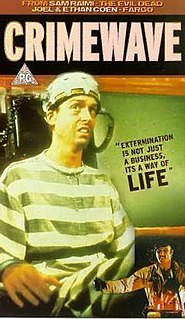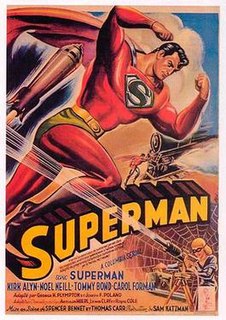In fiction, continuity is a consistency of the characteristics of people, plot, objects, and places seen by the reader or viewer over some period of time. It is relevant to several media.

A storyboard is a graphic organizer that consists of illustrations or images displayed in sequence for the purpose of pre-visualising a motion picture, animation, motion graphic or interactive media sequence. The storyboarding process, in the form it is known today, was developed at Walt Disney Productions during the early 1930s, after several years of similar processes being in use at Walt Disney and other animation studios.

Jaws is a 1975 American thriller film directed by Steven Spielberg, based on the 1974 novel by Peter Benchley. In the film, a man-eating great white shark attacks beachgoers at a summer resort town, prompting police chief Martin Brody to hunt it with the help of a marine biologist and a professional shark hunter. Murray Hamilton plays the mayor, and Lorraine Gary portrays Brody's wife. The screenplay is credited to Benchley, who wrote the first drafts, and actor-writer Carl Gottlieb, who rewrote the script during principal photography.
A screenplay, or script, is a written work by screenwriters for a film, television show, or video game. A screenplay written for television is also known as a teleplay. Screenplays can be original works or adaptations from existing pieces of writing. A screenplay is a form of narration in which the movements, actions, expressions and dialogue of the characters are described in a certain format. Visual or cinematographic cues may be given, as well as scene descriptions and scene changes.
A film producer is a person who oversees film production. Either employed by a production company or working independently, producers plan and coordinate various aspects of film production, such as selecting the script; coordinating writing, directing, editing; and arranging financing.

Star Trek: The Motion Picture is a 1979 American science fiction film directed by Robert Wise and based on the television series Star Trek created by Gene Roddenberry, who also served as its producer. It is the first installment in the Star Trek film series, and stars the cast of the original television series. In the film, set in the 2270s, a mysterious and immensely powerful alien cloud known as V'Ger approaches Earth, destroying everything in its path. Admiral James T. Kirk assumes command of the recently refitted Starship USS Enterprise, to lead it on a mission to save the planet and determine V'Ger's origins.
Filmmaking is the process by which a film is made. Filmmaking involves a number of complex and discrete stages, including an initial story, idea, or commission. It then continues through screenwriting, casting, shooting, sound recording, pre-production, editing, and screening the finished product before an audience that may result in a film release and an exhibition. Filmmaking occurs in a variety of economic, social, and political contexts around the world. It uses a variety of technologies and cinematic techniques.

Screenwriting or scriptwriting is the art and craft of writing scripts for mass media such as feature films, television productions or video games. It is often a freelance profession.

Ben-Hur is a 1959 American religious epic film directed by William Wyler, produced by Sam Zimbalist, and starring Charlton Heston as the title character. A remake of the 1925 silent film with a similar title, it was adapted from Lew Wallace's 1880 novel Ben-Hur: A Tale of the Christ. The screenplay is credited to Karl Tunberg, but includes contributions from Maxwell Anderson, S. N. Behrman, Gore Vidal, and Christopher Fry.
A production company, production house, production studio, or a production team is a business that provides the physical basis for works in the fields of performing arts, new media art, film, television, radio, comics, interactive arts, video games, websites, music, and video. Production teams consist of technical staff to produce the media. Generally the term refers to all individuals responsible for the technical aspects of creating a particular product, regardless of where in the process their expertise is required, or how long they are involved in the project. For example, in a theatrical performance, the production team has not only the running crew, but also the theatrical producer, designers and theatrical direction.

The Terror is a 1963 American independent horror film produced and directed by Roger Corman. The film stars Boris Karloff and Jack Nicholson, the latter of whom portrays a French officer who is seduced by a woman who is also a shapeshifting devil.

Laserblast is a 1978 American science fiction film about an unhappy teenage loner who discovers an alien laser cannon and goes on a murderous rampage, seeking revenge against those who he feels have wronged him. The extremely low-budget film was directed by Michael Rae and produced by Charles Band, who is widely known for producing B movies. Starring Kim Milford, Cheryl Smith, and Gianni Russo, the film features Keenan Wynn and Roddy McDowall, and marked the screen debut of actor Eddie Deezen.

House of Dracula is a 1945 American horror film released by Universal Pictures. Directed by Erle C. Kenton, the film features several Universal Horror properties meeting as they had done in the 1944 film House of Frankenstein. The film is set at the castle home of Dr. Franz Edelmann, who is visited first by Count Dracula and later by Larry Talbot, the Wolf Man, who are trying to cure their vampirism and lycanthropy, respectively. Talbot can not be cured, which leads him to discover the body of Frankenstein's monster in a cave below the base of the castle. Edelemann takes the monster's body back to his laboratory, but finds Count Dracula has awoken and by attacking his assistants, he captures Edelmann and forces a reverse blood transfusion, which gives Edelmann a split personality that likes to wreak havoc with those around him.

Crimewave is a 1985 American comedy horror film directed by Sam Raimi, written by him and the Coen brothers, and starring Louise Lasser, Paul L. Smith, Brion James, Sheree J. Wilson, Edward R. Pressman, Bruce Campbell, and Reed Birney, with Campbell also serving as a producer. Following the commercial success of The Evil Dead (1981), Raimi and Campbell decided to collaborate on another project. Joel Coen of the Coen brothers served as one of the editors on The Evil Dead, and worked with Raimi on the screenplay. Production was difficult for several members of the crew, and the production studio, Embassy Pictures, refused to allow Raimi to edit the film. Several arguments broke out during the shoot of the film due to continued interference by the studio.
Filmmaker, or "Filmmaker: a diary by george lucas", is a 32-minute documentary made in 1968 by George Lucas about the making of Francis Ford Coppola's 1969 film The Rain People.

Amblin' is a 1968 American short film written and directed by Steven Spielberg. It was Spielberg's first completed film shot on 35 mm. The film is a short love story set during the hippie era of the late 1960s about a young man and woman who meet in the desert, attempt to hitchhike, become friends, then lovers, make their way to a beach, and part ways. It later became the namesake for Spielberg's production company, Amblin Entertainment.

Superman is a 1948 15-part Columbia Pictures film serial based on the comic book character Superman. It stars an uncredited Kirk Alyn and Noel Neill as Lois Lane. Like Batman (1943), it is notable as the first live-action appearance of Superman on film, and for the longevity of its distribution. The serial was directed by Thomas Carr, who later directed many early episodes of the Adventures of Superman television series, and Spencer Gordon Bennet, produced by Sam Katzman, and shot in and around Los Angeles, California. It was originally screened at movie matinées, and after the first three scene-setting chapters, every episode ends in a cliffhanger. The Superman-in-flight scenes are animations, in part due to the small production budget.
The production of The Lord of the Rings film series under Peter Jackson's direction was an enormous challenge, starting in 1997 and ending in 2004. Many earlier attempts had failed; most that had reached the screen were animations, and many filmmakers and producers had considered how to achieve the task and then set it aside. The series as realized consists of three epic fantasy adventure films based on J. R. R. Tolkien's eponymous novel. They were produced by New Line Cinema, assisted by WingNut Films; the cinema versions appeared between 2001 and 2003, and the extended edition for home video in 2004. Development began in August 1997. The three films were shot simultaneously, entirely in Jackson's native New Zealand, from October 1999 until December 2000, with pick-up shots from 2001 to 2004.

Von Richthofen and Brown, alternatively titled The Red Baron, is a 1971 war film directed by Roger Corman and starring John Phillip Law and Don Stroud as Manfred von Richthofen and Roy Brown. Although names of real people are used, the story by Joyce Hooper Corrington and John William Corrington makes no claim to be historically accurate, and in fact is largely fictional.

The Young Racers is a 1963 sports drama film directed by Roger Corman and starring Mark Damon, William Campbell, Luana Anders and Patrick Magee. It is based on the Formula One races in Europe.













